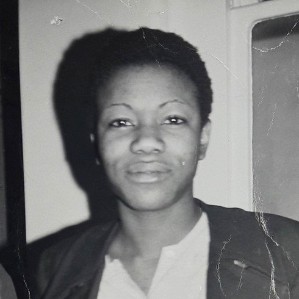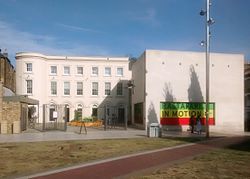
Brixton is an area of South London, part of the London Borough of Lambeth, England. The area is identified in the London Plan as one of 35 major centres in Greater London. Brixton experienced a rapid rise in population during the 19th century as communications with central London improved.
Dame Jocelyn Anita Barrow was a British educator, community activist and politician, who was the Director for UK Development at Focus Consultancy Ltd. She was the first black woman to be a governor of the British Broadcasting Corporation (BBC) and was founder and Deputy Chair of the Broadcasting Standards Council.
Rahasya Rudra Narayan, commonly known as Rudy Narayan, was a barrister and civil rights activist in Britain. He migrated to Britain in the 1950s from Guyana.

Ronald "Charlie" Phillips, also known by the nickname "Smokey", is a Jamaican-born restaurateur, photographer, and documenter of black London. He is now best known for his photographs of Notting Hill during the period of West Indian migration to London; however, his subject matter has also included film stars and student protests, with his photographs having appeared in Stern, Harper’s Bazaar, Life and Vogue and in Italian and Swiss journals. Notable recent shows by Phillips include How Great Thou Art, "a sensitive photographic documentary of the social and emotional traditions that surround death in London's African Caribbean community".

Olive Elaine Morris was a Jamaican-born British-based community leader and activist in the feminist, black nationalist, and squatters' rights campaigns of the 1970s. At the age of 17, she claimed she was assaulted by Metropolitan Police officers following an incident involving a Nigerian diplomat in Brixton, South London. She joined the British Black Panthers, becoming a Marxist–Leninist communist and a radical feminist. She squatted buildings on Railton Road in Brixton; one hosted Sabarr Books and later became the 121 Centre, another was used as offices by the Race Today collective. Morris became a key organiser in the Black Women's Movement in the United Kingdom, co-founding the Brixton Black Women's Group and the Organisation of Women of African and Asian Descent in London.

Lenford Alphonso (Kwesi) Garrison was an educationalist, community activist and historian whose life's work was to catalogue the development of the black British identity and its history and promote the works of young black writers. To this end, he set up ACER and co-founded the Black Cultural Archives.

James Barnor Hon. FRPS, OV is a Ghanaian photographer who has been based in London since the 1990s. His career spans six decades, and although for much of that period his work was not widely known, it has latterly been discovered by new audiences. In his street and studio photography, Barnor represents societies in transition in the 1950s and 1960s: Ghana moving toward independence, and London becoming a multicultural metropolis. He has said: "I was lucky to be alive when things were happening...when Ghana was going to be independent and Ghana became independent, and when I came to England the Beatles were around. Things were happening in the 60s, so I call myself Lucky Jim." He was Ghana's first full-time newspaper photographer in the 1950s, and he is credited with introducing colour processing to Ghana in the 1970s. It has been said: "James Barnor is to Ghana and photojournalism what Ousmane Sembène was to Senegal and African cinema."
Raleigh Hall is a building in Windrush Square, Brixton. It is now home to the Black Cultural Archives, after being derelict for many years.
Ajamu X is a British artist, curator, archivist and activist. He is best known for his fine art photography which explores same-sex desire, and the Black male body, and his work as an archivist and activist to document the lives and experiences of black LGBTQ people in the United Kingdom (UK).

Lambeth Town Hall, also known as Brixton Town Hall, is a municipal building at the corner of Brixton Hill and Acre Lane, Brixton, London. The town hall, which is the headquarters of Lambeth London Borough Council, is a Grade II listed building.
Nubian Jak Community Trust (NJCT) is a commemorative plaque and sculpture scheme founded by Jak Beula that highlights the historic contributions of Black and minority ethnic people in Britain. The first NJCT heritage plaque, honouring Bob Marley, was unveiled in 2006 after "two years of research and behind the scenes negotiating". The scheme has been run and managed by the not-for-profit organization Nubian Jak Trust Ltd since August 2016, with a remit to commemorate and celebrate the diverse history of modern Britain. Its objectives include the promotion of social equality and to encourage activities that promote cultural diversity in society.

The African and Caribbean War Memorial in Brixton, London, is the United Kingdom's national memorial to African and Caribbean service personnel who fought in the First and Second World Wars. It originated with a project for a memorial to Caribbean Royal Air Force veterans of World War II who arrived in Britain in 1948 on the MV Empire Windrush; this was an extension of the commemorative plaque and sculpture scheme run by the Nubian Jak Community Trust to highlight the historic contributions of Black and minority ethnic people in Britain. The memorial was originally to have been placed at Tilbury Docks, as part of the commemoration for the centenary of the outbreak of World War I. However, as the project began to evolve into a larger tribute that included both World Wars and commemorated servicemen and women from both Africa and the Caribbean, it was agreed by the memorial recipient – the Port of Tilbury – and the project organisers that a new, more accessible location needed to found. The memorial was ultimately permanently installed and unveiled on 22 June 2017 in Windrush Square, Brixton.

Windrush Square is an open public space in the centre of Brixton, South London, occupying an area in front of the Brixton Tate Library. After changing its name to Tate Gardens, it was again retitled and given its current moniker in 1998. The square was renamed to recognise the important contribution of the African Caribbean community to the area, marking the 50th anniversary of the arrival of the HMT Empire Windrush. It was the Windrush that in 1948 brought to the United Kingdom from Jamaica the largest group thus far of post-war West Indian migrants, 236 of whom had no abode on arrival and were temporarily housed in the deep-level air raid shelter in Clapham Common. Some 1.7 mile away, at the western end of Coldharbour Lane in Brixton, was the nearest employment exchange to the shelter. Many of these migrants eventually found accommodation in the area.
Patrick Philip Vernon is a British social commentator and political activist of Jamaican heritage, who works in the voluntary and public sector. He is a former Labour councillor in the London Borough of Hackney. His career has been involved with developing and managing health and social care services, including mental health, public health, regeneration and employment projects. Also a film maker and amateur cultural historian, he runs his own social enterprise promoting the history of diverse communities, as founder of Every Generation and the "100 Great Black Britons" campaign. He is also an expert on African and Caribbean genealogy in the UK. He was appointed a Clore Fellow in 2007, an Officer of the Order of the British Empire (OBE) in the 2012 Birthday Honours for "services to the Reduction of Health Inequalities for Ethnic Minorities", and in 2018 was awarded an honorary doctorate from the University of Wolverhampton.
Neil Emile Elias Kenlock is a Jamaican-born photographer and media professional who has lived in London since the 1960s. During the 1960s and 1970s, Kenlock was the official photographer of the British Black Panthers, and he has been described as being "at the forefront of documenting the black experience in the UK". Kenlock was co-founder of Choice FM, the first successful radio station granted a licence to cater for the black community in Britain.
Windrush Day is a commemoration in the United Kingdom held on 22 June to honour the contributions of migrants to the post-war economy. Specifically, it celebrates Afro-Caribbeans who began arriving on the HMT Empire Windrush in 1948. Later known as the "Windrush generation", these economic migrants were an important part of the UK's recovery from the privations of World War II. Windrush Day is not a bank holiday but has grown in popularity since a campaign by Patrick Vernon led to its introduction in 2018.
Arthur Torrington CBE is a Guyanese-born community advocate and historian who is Director and co-founder of the London-based Windrush Foundation, a charity that since 1996 has been working to highlight the contributions to the UK of African and Caribbean peoples, "to keep alive the memories of the young men and women who were among the first wave of post-war settlers in Britain", and to promote good community relations. The organization commemorates in its name the Empire Windrush, the ship that on 22 June 1948 docked at Tilbury bringing the first significant group of Caribbean migrants to Britain, including Sam King, who with Torrington established the Windrush Foundation.
Museumand: The National Caribbean Heritage Museum is a group that celebrates the contribution of British African-Caribbean people to life in the United Kingdom. The group is a "museum without walls" based in Nottingham, and who work with communities there and elsewhere, including mounting exhibitions in museums, universities and other places. It was founded in 2015 by Catherine Ross as the SKN cultural museum, and Museumand is a subsidiary of the SKN Heritage Museum Community interest company.
The Brixton Immortals Domino Club formed in the 1970s, is a team and wider community social club playing Dominoes in Brixton, London, United Kingdom.










